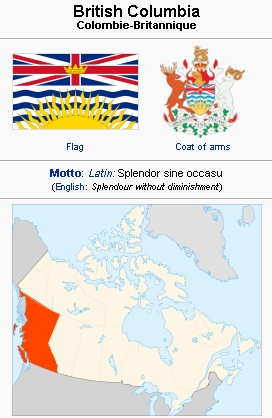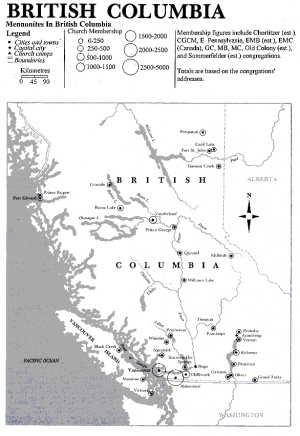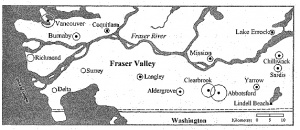British Columbia (Canada)
Introduction
British Columbia (BC) is the westernmost of Canada's provinces. It is located along the Pacific Ocean and is bordered by the U.S. state of Alaska on the northwest, on the north by the Yukon and the Northwest Territories, on the east by the province of Alberta, and on the south by the U.S. states of Washington, Idaho, and Montana. With a total area of 944,735 km2 (364,764 sq mi), it is the 5th largest province/territory in Canada. British Columbia is mostly mountainous, with 60% of the province covered by forests. Only 5% of the province is comprised of arable land, with most agriculture located in the Fraser Valley and the Okanagan. The total population in 2010 was estimated to be 4,510,858. Vancouver is the largest city in the province, while Victoria is the capital.
British Columbia's name was chosen by Queen Victoria in 1858 when the Colony of British Columbia was formed to distinguish the British sector of the Columbia District north of the 49th parallel from American or Southern Columbia, which had become the Oregon Territory in 1848.
Europeans began to settle in the area in the mid-18th century. At that time, the aboriginal population in the region was fairly large, representing half of all aboriginal people in present-day Canada. Smallpox epidemics amongst the aboriginals caused many deaths, with 50% of the aboriginal population dying in the Great Smallpox Epidemic of 1862 alone. British control was established through the explorations of James Cook in 1778 and George Vancouver in 1792-93. The fur trade led to the establishment of trading posts in the area by the North West Company and Hundson's Bay Company. The Fraser Canyon Gold Rush of 1858, followed by the Cariboo Gold Rush of 1862, led to a further influx of settlers in the area.
British Columbia's economy has always been resource dominated. Forestry is the most important economic sector, followed by tourism, mining, agriculture, and fishing.
British Columbia has a very diverse population in terms of ethnic backgrounds. In 2006, the top ten ethnic groups reported in British Columbia were: English, 29.63%; Scottish, 20.32%; Irish, 15.17%; German, 13.78%; Chinese, 10.6%; French, 8.86%; Indian, 5.7%; Ukrainian, 4.84%; Dutch, 4.82%; and North American Indian, 4.74%. Visible minorities represented 24.8% of the province's population.
The 2001 census reported the following religious affiliations: No religious affiliation, 35.1%; Roman Catholic, 17.2%; United Church of Canada, 9.4%; Anglican Church, 7.7%; other Christian (not Protestant), 5.2%; Sikh, 3.5%; Baptist, 2.8%; Lutheran, 2.6%; Buddhist, 2.2%; and other Protestant, 2%. BC is the only province in Canada that reports no religion as the highest response category. The province has a lower proportion of Roman Catholics than any other province in Canada, and its Protestant population has declined from 42% of the total population in 1991 to 31% in 2001.
1990 Article
By 1911 a Mennonite settlement had taken root at Renata along the Arrow lakes in SE British Columbia. The settlers' source of livelihood was fruit growing and timber processing. They built a school and organized Sunday school classes and church services in which lay and visiting ministers played a leading role. In the mid-1960s the community was relocated when a nearby hydroelectric dam flooded the valley.

In 2001, Mennonites in British Columbia worshiped in about 145 congregations from the NE Peace River valley to Vancouver Island, with a total membership of approximately 22,550. Most resided in the Fraser Valley and the city of Vancouver. Almost 100 congregations were affiliated with the British Columbia Provincial Conference of Mennonite Brethren Churches and 35 with Mennonite Church British Columbia, the provincial level of the Mennonite Church Canada. There were four Church of God in Christ, Mennonite (Holdeman), congregations, one Fellowship of Evangelical Bible Churches congregation (formerly the Evangelical Mennonite Brethren), two Evangelical Mennonite Conference (EMC) congregations, one Chortitzer Mennonite Conference congregation, three Old Colony Mennonite congregations, and four Eastern Pennsylvania Mennonite Church congregations. Mennonites worshiped in a variety of languages, including German, English, Mandarin, Cantonese, Vietnamese, Punjabi, Spanish, Russian, Indonesian, Arabic, Farsi, Laotian, Korean and American Sign Language. The conferences saw church planting as a high priority.
Since the 1950s Mennonites have become more urbanized as the Fraser valley has acquired suburban characteristics. Dairy farming, fruit growing, and poultry raising are still important ways of making a living, but British Columbia Mennonites are increasingly entering the commercial and professional fields. Growing material success seems to be muting the traditional Anabaptist renunciation of secular society. Mennonites are relating more to evangelical Christian groups. They share with them an emphasis on regeneration, evangelism, and personal piety, characteristics also of the 16th century Anabaptists. At the same time some evangelicals are recognizing that the gospel confronts social and economic injustice and militarism. Interaction between Mennonites and the broader evangelical movement may therefore help both to speak directly to peace and justice issues.
British Columbia Mennonites serve society jointly and as individual congregations. Since the 1950s, the provincial Mennonite Brethren and the Conference of Mennonites in British Columbia have cooperated through Mennonite Central Committee (MCC B.C.) and through educational ventures.
MCC B.C. was established in the 1940s. Siegfried Bartel served as chair during much of the 1970s and 1980s, and before him Gerhard Thielmann served for 17 years. In addition to MCC's global and national program it is involved in supportive care services for the developmentally disabled. MCC B.C. has established three group homes as well as a Community Living Program in which MCC staff provide assistance to mentally challenged people living in their own homes. It also provides a day school and a self-help craft program for the handicapped. Through its Peace and Service Committee, MCC B.C. has organized annual children's festivals to introduce children, within the context of their family, to their Mennonite heritage and to the MCC program. In 1986 MCC BC's Social Housing Society opened the doors of an apartment building in Vancouver with the goal of providing affordable housing for the poor. MCC BC sponsors a number of voluntary service units and a growing number of annual relief sales.
Initiatives also come from individual congregations. In 1982 Langley Mennonite Fellowship launched its Victim Offender Reconciliation Program. It seeks to reconcile the victim of a crime with the offender in such a way that offenders recognize the effects of their actions on victims, and in some way make restitution.
Mennonite women are active in British Columbia. They meet monthly in individual congregations for fellowship, meditation, sewing, knitting, and quilting. The sale of their products provides MCC B.C. with a substantial part of its annual budget. After World War II, General Conference Mennonite women operated the Mary-Martha Home for young women in Vancouver, which took in women recently arrived in the city and put them in touch with employers. In 1985 the Open Door in Aldergrove was established by women to serve economically deprived single mothers.
In 1970-71 the two major conferences agreed to operate one Bible school. Because attendance at Bethel Bible Institute in Abbotsford diminished in the 1960s, the Conference of Mennonites (GCM) held a special study conference in 1967 on the future of their school. As a result of discussions with the Mennonite Brethren, whose Mennonite Brethren Bible Institute (MBBI) had been growing during the 1960s, it was decided to close Bethel and join forces with MBBI in nearby Clearbrook (now part of Abbotsford). The result was Columbia Bible Institute (CBI), with students and faculty from both conferences. In 1982 the Conference of Mennonites in British Columbia joined the Mennonite Brethren provincial conference as owners and governors of CBI. It was the first inter-Mennonite Bible institute in North America and had as its goal "to actively promote and teach a strong evangelical, Anabaptist (Mennonite) theology...." In 1985 the school was renamed Columbia Bible College; it is accredited by the American Association of Bible Colleges.
Mennonites in British Columbia also cooperated in ministering to university students. In 1986 the Menno Simons Centre was established near the University of British Columbia campus. The center consisted of a residence for some 20 students with a small chapel. It has served both as headquarters for student ministry for other students enrolled in the province's institutes of higher learning and as a retreat center.
Mennonite Educational Institute in Clearbrook, founded in 1944 by ten Mennonite Brethren congregations, is also a cooperative venture, run by a society of Mennonite Brethren and General Conference Mennonite congregations. It has provided secondary school education for students from its beginnings, and more recently has added elementary classes to its curriculum. In 2000 it was supported by 14 churches in Abbotsford, Aldergrove, Langley, Mission and Arnold. -- John M. Klassen
Bibliography
Baerg, George G. A Brief History Mennonites in British Columbia. Yarrow: Columbia Press, 1967.
Barg, George G. "The Mennonites" in Strangers Entertained: A History of Ethnic Groups in British Columbia, ed., John Norris. Vancouver: B.C. Centennial Committee, 1971: 185-90.
Hertzler, Daniel. From Germantown to Steinbach. Scottdale, 1981: 186-97.
Horsch, James E., ed. Mennonite Yearbook & Directory, 1997.Scottdale, Pa.: Mennonite Publishing House, 1997: 12-13.
Janzen, Adina and Winnie Dueck, eds. History of B.C. Mennonite Women in Mission 1939-1976. Chilliwack.
Klassen, Abram J., ed. The Bible School Story (1913-1963). Clearbrook: General Board of Education, MB Conference, 1963.
Klassen, Agatha, ed. Yarrow: A Portrait in Mosaic. Yarrow: A. E. Klassen, 1976.
Klippenstein, Lawrence. "Early Mennonites in B.C.: Renata, 1907-1965." Mennonite Historian 7:3, 1-2; 7:4, 2
Krahn, John J. "A Social History of Mennonites in British Columbia." MD thesis, School of Medicine, U. of British Columbia, 1955.
Lohrenz, Gerhard. The Mennonites in Western Canada. Steinbach: Duerksen Printers, 1974.
Statistics Canada. "British Columbia: One-third Report No Religion." Web. 24 September 2011. http://www12.statcan.ca/english/census01/Products/Analytic/companion/rel/bc.cfm.
Die Vereinigten Mennoniten Gemeinden in British Columbien. Yarrow: Columbia Press, 1959.
Warkentine, Mary and Rose Ann Rahn, eds. The Story of Renata. Renata, B.C. 1965.
Wikipedia. "British Columbia." Web. 24 September 2011. http://en.wikipedia.org/wiki/British_Columbia.
Wikipedia. "Demographics of British Columbia." Web. 24 September 2011. http://en.wikipedia.org/wiki/Demographics_of_British_Columbia.
Additional Information
Conference and Educational Institution Websites
British Columbia Conference of Mennonite Brethren Churches
Mennonite Educational Institute
Mennonite Church British Columbia
Original Mennonite Encyclopedia Article, 1955
British Columbia is the "California" of Canada. Thousands have been attracted to Canada's Pacific shores by the mild climate and the pleasant, fertile valleys. In the period 1941-1944 alone, over 90,000 Canadians migrated to the West Coast province. The province is Canada's third largest, with an area of 366,255 square miles, largely mountainous. The coast line is very irregular, indented with many fiord-like inlets, and measures 7,000 miles in length. The province extends from the Pacific to the height of land in the Rocky Mountains, a maximum of 600 miles, and from Alaska to the State of Washington.
In 1846 the Oregon Treaty cut the Northwest in two, drawing the present international boundary line between the United States and Canada at the 49th parallel of latitude. Vancouver Island was created a Crown colony of Great Britain in 1849. In 1858 the mainland was also made a Crown colony, thus ending the rule of the fur-trading companies. The island and the mainland united to form British Columbia in 1866, and in 1871 British Columbia became a province of the newly formed Dominion of Canada. At that time the province contained 36,000 whites. At present, well over one million people inhabit the cities and the valleys of the province. Lumbering, mining, fishing, agriculture, and manufacturing are the major pursuits of the people.
Mennonites have come to British Columbia in large numbers. The first came in 1928, mainly from the prairies, and built homes in what is now the town of Yarrow, about 40 miles inland from Vancouver. The settlers were poor and worked at any jobs that offered themselves, in the forests, on the farms, in the hop fields, and thus managed to eke out a bare living for themselves and their families. The settlement grew very rapidly, its present population being over 2,000. It is British Columbia's largest single Mennonite community, and is unique in that it is a completely Mennonite town. Most of the settlers came, here as elsewhere, from the drought-stricken areas of the prairie provinces after 1940, or from the new immigration from Russia after 1947.
The area around the town of Abbotsford, a few miles west of Yarrow, was the next site chosen by the Mennonites for settlement. The land was covered with light timber, and heavily dotted with the giant stumps of large, old trees. Several families began the difficult task of hewing homes out of the forest in 1930. They were very poor, the Depression was at its height, and the only equipment available for land clearing was the ax and the saw. The group's only income was derived from what little could be earned in working for others. It was not until 1939 that economic independence was beginning to be attained. But thereafter great forward strides were made. Bulldozer, dynamite, and fire soon conquered the stumps, and the land was made ready for farming. Today comfortable farms cover the area.
In looking for a means of livelihood many Mennonites went to the near-by city of Vancouver. A permanent group developed there, and the city now has two sizable congregations, General Conference Mennonite and Mennonite Brethren.
As their numbers increased, the Mennonites diffused throughout the whole of the lower Fraser River Valley. Congregations are now to be found at Vancouver, Strawberry Hill, Aldergrove, Abbotsford, Matsqui, Mission, Arnold, Yarrow, Greendale, Chilliwack, East Chilliwack, Black Creek on Vancouver Island, and Kelowna in the interior, a total of 22. The most numerous group is the Mennonite Brethren, followed by the General Conference Mennonites. There are also small groups of Evangelical Mennonite Brethren, and a number of Holdeman Mennonites (Church of God in Christ, Mennonite). Four Bible schools are maintained. At one time there were three private Mennonite high schools, but at present only one remains, that at Abbotsford.
The Mennonite community of British Columbia has grown from a few persons in 1928 to over 15,000 in 1951 (2,000 D. P.’s [Displaced Person's] from Europe have settled in BC since 1947), living in an area about 70 miles long by 15 miles wide. With the exception of those in the city congregations, almost all are engaged in dairying, small fruit growing, or poultry raising. -- Cornelius F. Klassen
| Author(s) | Cornelius F. Klassen |
|---|---|
| John M. Klassen | |
| Richard D. Thiessen | |
| Date Published | September 2010 |
Cite This Article
MLA style
Klassen, Cornelius F., John M. Klassen and Richard D. Thiessen. "British Columbia (Canada)." Global Anabaptist Mennonite Encyclopedia Online. September 2010. Web. 16 Apr 2024. https://gameo.org/index.php?title=British_Columbia_(Canada)&oldid=114357.
APA style
Klassen, Cornelius F., John M. Klassen and Richard D. Thiessen. (September 2010). British Columbia (Canada). Global Anabaptist Mennonite Encyclopedia Online. Retrieved 16 April 2024, from https://gameo.org/index.php?title=British_Columbia_(Canada)&oldid=114357.
Adapted by permission of Herald Press, Harrisonburg, Virginia, from Mennonite Encyclopedia, Vol. 1, pp. 430-431; vol. 5, pp. 98-101. All rights reserved.
©1996-2024 by the Global Anabaptist Mennonite Encyclopedia Online. All rights reserved.


